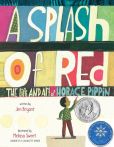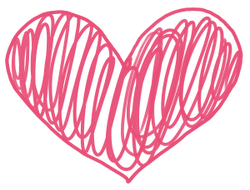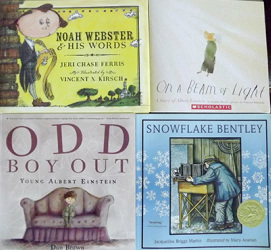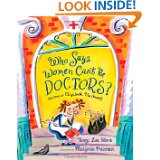 Most of you know I've been working on a picture book biography, and I'm finished with the story part and have been polishing up the back matter. Thank God for back matter! Do you know why? Well, I spent probably 2 1/2 - 3 months of research on this person; my Evernote online notebook is full and so is my real hard copy notebook. But when I revised and revised this story, I had to cut out many facts and areas of this person's life. It was extremely painful. All those months of digging up these gems of facts and anecdotes, only to ditch them. But wait...those facts aren't gone forever. I can use them in my back matter or save them for a future web site spot for students and teachers. Relief!  So exactly what belongs in the back matter? I've been studying the pros, and the sky's the limit. Each book is unique in how its handled. Some leave a small author's note explaining how they were connected with the subject. Others leave 2-3-4 pages of additional information. Here are some examples: In Noah Webster and His Words, the story stops on page 29. A double-spread timeline takes up pages 30-31, and on page 32 is more about Noah's life, and a bibliography divided into primary resources, secondary resources, and web sites. In A Beam of Light, there are 14.5 spreads of story, then one double-spread with the author's note, four sections of additional information about Albert Einstein, and then books for further reading, plus one web site. A Splash of Red includes 5 pages of back matter! The first page has a historical note (more info about Horace Pippin) plus his real photograph. The next spread includes the author's note, illustrator's note, a list of books for further reading, a film, web sites, quotation sources, and an acknowledgements section (thanking everyone who helped with the book including museum people). The last spread in the back matter is a map of places to find Horace's art. Who Says Women Can't Be Doctors has a double spread with the author's note of more about Elizabeth Blackwell and sources used.  Vintage Scissors Vintage Scissors Wow. The back matter is no simple matter! I think the more you have to offer the editor is better. And then the editor can choose what to use. I've already written a short author's note of how I'm connected with my subject, additional information about my subject (mostly those facts I had to cut out of the original story), a timeline, and a bibliography separated by primary and secondary sources. Perhaps I should slim the sources down for "further reading" for children. I also have a list of photographs in public domain that might be helpful to the future illustrator. I realized all this back matter must fit within the confines of a 32 page picture book unless the publisher decides on extra pages. Oh no! Perhaps more cutting. If you want to read more about back matter, I found a few posts. "Today's Picture Book Biographies: Back Matter Matters," The Horn Book. "How to Handle Picture Book Back Matter During Submission" Dear Editor.com (read the comments, too) "Beautiful Back Matter," INK (Interesting Nonfiction for Kids) web site What are your thoughts? What do you think should be included?
16 Comments
 I just finished a wonderful four weeks of Nonfiction Archaeology. It's an online class taught by Kristen Fulton about how to write nonfiction picture books. I was in the inaugural class and had a wonderful time meeting new kidlit peeps. Each Monday night is a live webinar which you can participate in or listen to the recording if you can't make it. And each weekday a lesson is emailed to you. And the best part is the communication among classmates and instructor in a Facebook group. I thrive on feedback. And if you've been following along in my blog, you know I've been working on a picture book biography. I'm so glad for this class and for my critique groups who have helped shape my story. If you're interested in writing nonfiction, I hope you can take this class. It begins the first Monday of each month. I learned a great technique from Kristen in writing picture book biographies, but I'm not spoiling the beans... You have to take the class to find out. By the way, I've taken many writing classes, and probably so have you. I've learned tidbits from each instructor that I can use to make my writing stronger. So dig in!  The second thing I wanted to share with you is that I'm now part of a group called GROG. We are writers who are teaming up as a group to blog each day about writing. We go live on March 3rd. I'll be posting 2-3 times a month as well. Our aim with this blog is to provide: G: Guidance and support R: Resources on the craft of writing O: Opportunities to expand our skills G: Great folks who support readers and writers of all ages! I hope you check out our GROG Blog here and bookmark it or subscribe. Maybe some of you can be guest authors on our GROG. Have a great writing week! I know I will. Just got back from Costco here, and they now carry crunchy CHEETOS from America! :) See, it's the little things that can make your day.  Welcome back to my journey of picture book biography writing. While you've been gone, I found ANOTHER descendant of my subject, and we talked on the phone for almost two hours! It was awesome discussing my subject with someone else more knowledgeable. While studying picture book biographies, I've noticed that they fall into two categories: a story about the person's whole life from birth to death or one part of the person's life. I'll call these options the whole biography pie or a slice of biography pie. As always, I like to look at great examples. What's better than a book that received two recent ALA awards for nonfiction? I purchased on Kindle A Splash of Red: The Life and Art of Horace Pippin by Jen Bryant, illustrated by Melissa Sweet, Knopf 2013. Opening line: On February 22, 1888, the town of West Chester, Pennsylvania, celebrated a holiday. That day, in that same town, Daniel and Christine Pippin celebrated the birth of their son, Horace. (This book uses the setting to begin.) Description: Horace is a big boy who's a great helper, and he loves to draw. When he wins a drawing contest, he receives real paints and draws as much as he can. But times are tough and then there's a war. Horace is called away, and something happens that prevents him from doing what he loves best until...  Here are some things I learned about picture book biography writing from this book:
I really enjoyed this book and learned so much from it. I hope you get the chance to read it. And here's a FABULOUS interview of Jen and Melissa on the making of this book. So will you be baking a whole biography pie or just a slice?  The best biographies are those that peek into the heart and soul of their subject. They delve deep beneath the surface of “fact” to find the real human story. ~ Candace Fleming A neat opportunity happened a week ago. I interviewed a living descendant of the person I'm writing a picture biography about. You might be thinking--how did you find a living relative? Lots of hunting on the Internet. I really felt like a stalker! A school was named after my person and celebrating its 100th anniversary. A law paper about it listed all the living descendants! Thanks to Kristen Fulton of our WOW Nonfiction Facebook group, she suggested looking up the descendants on Spokeo.com for phone numbers and addresses. I also searched them on Facebook and found two, but they didn't answer my messages or friend requests. I don't blame them; I don't friend strangers either. White Pages.com and Anywho.com also helped me narrow down phone numbers. Then, I said a prayer, and with enough courage, called. I couldn't believe she answered the phone. She's the great-granddaughter and 88 years old. I think she was more surprised that I was calling from South Korea. We had a lovely conversation later that day, but to be honest, she didn't really give me any new information. However, she did stress some details that I thought weren't as important. So now I'm re-looking at those areas. She also told me to call another relative, which I still have to do after I do another step. I ordered in some actual books on my subject from Amazon. Otherwise, all my sources, journals and autobiographies, have been online through the Library of Congress Archives. I'm so fortunate I can research while in another country! So I'm currently reading these books, and then I'll call relative #2. I've also read from some of the experts in the picture book biography field. Kathleen Krull likes to read actual books about her subject first rather than autobiographies, journals, and diaries, because she says people can lie about themselves. She reads what the best scholars have to say about the person or topic. Candace Fleming likes to use all sorts of materials, books, Internet, newspapers, etc...plus she travels to the place her person lived. Since I can't do option #2, I'm now doing option #1. However, I started opposite Kathleen. I read all of the journals online first and am now reading what scholars said about her. And the cool thing about this--the scholars WENT to the university libraries and read all the letters and nitty-gritty that's not online. So it's like they did all the research for me. haha. And finding out what other authors said about my person is also enlightening. I'm still debating the emotional arc or heart of my biography. So it's neat to see what character qualities they picked up on. I wanted to share some expert advice from the picture book biography authors that have been useful to me. The links are below. I did write my bad first draft and have sent it to my critique groups. Now it's time to rewrite, now that I know more of the heart of my biography. Awesome interviews of Candace Fleming and Kathleen Krull on writing biographies A video interview of Tanya Lee Stone, watch "A Person's Story" Kathleen Krull has lots of links and information for authors I hope this is helpful. If you know of other helpful sources, please share.  I'm so glad last week's post was helpful to so many of you. To continue on in this subject, I'm going to skip to the endings of picture book biographies, even though it's not the end of January. As picture book biography writers, once we have our beginning sentence, we need to know how the story is going to end, that way we can build the middle. Unfortunately, the Amazon "Look" feature is no help here. But thankfully, I have some picture book biographies in my collection and ones I bought through Amazon Kindle. Just for the record, I'm no expert! I'm writing these posts mainly for my benefit as I learn this genre. I'm going to categorize the endings like I did with the beginnings, although I don't have as many to use. But bear with me, and if you have some to share, please do in the comments, and I can add them. A picture book ending should fulfill a promise that you made in the beginning. If you write about Eli Whitney and the cotton gin in the beginning, then you should end with Eli Whitney and his great invention, not with some other topic like how cotton is grown. It's called coming full circle. And I realized something else, which I'll share at the end. :) I'm first going to list the beginning and then the ending, so you can see how that ending fulfills the promise made in the beginning, plus categorize the ending so you can see ways authors have ended their biographies. Quirky Endings - the ending emphasizes the quirk or special trait that made this person unique Noah Webster and His Words by Jeri Chase Ferris, Houghton Mifflin 2012 Beginning: Noah Webster always knew he was right, and he never got tired of saying so (even if, sometimes, he wasn’t). He was, he said, “full of CON-FI_DENCE” [noun: belief that one is right] from the very beginning. Ending: Noah Webster's words did unite America. He always knew he was right! Odd Boy Out: Young Albert Einstein, by Don Brown, Houghton Mifflin 2004 Beginning: On a sunny, cold Friday in the old city of Ulm, Germany, a baby named Albert Einstein is born. It is March 14, 1879. The joy his family has for the new birth is brief. His grandmother cries, "Much too fat. Much too fat." And his mother fears his head is too big. Ending: For the world, Einstein comes to mean not fat baby, or angry child, or odd boy, but great thinker. Quirk + thanks + review of person's greatness - This ending emphasizes what the person has done, usually because of their quirky trait. Snowflake Bentley by Jacqueline Briggs Martin, Houghton Milfflin 1998 Beginning: In the days when farmers worked with ox and sled and cut the dark with lantern light, there lived a boy who loved snow more than anything else in the world. Ending: Neighbors and strangers have come to know of the icy wonders that land on their own mittens--thanks to Snowflake Bentley. Talks to the Reader Who Says Women Can't Be Doctors? The Story of Elizabeth Blackwell by Tanya Lee Stone, Christy Ottaviano (Henry Holt) 2013 Beginning: I'll bet you’ve met plenty of doctors in your life. And I’ll bet lots of them were women. Well, you might find this hard to believe, but there once was a time when girls weren’t allowed to become doctors. Ending: She had become the first woman doctor in America. Although many people were proud, others were angry. One doctor even wrote, “I hope, for the honor of humanity, that [she]will be the last.” But as you know, she certainly was NOT. On a Beam of Light: The Story of Albert Einstein, by Jennifer Berne, Chronicle 2013 Beginning: Over 100 years ago, as the stars swirled in the sky, as the Earth circled the sun, as the March winds blew through a little town by a river, a baby was born. His parents named him Albert. Ending: But still, Albert left us many big questions. Questions that scientists are working on today. Questions that someday you may answer...by wondering, thinking, and imagining. *This one also ends using Albert's quirk of always asking questions which is introduced in the middle of the book, rather than the beginning. Notice that each book emphasized in some way a quirk or trait that made the person unique for his/her greatness. AND, my realization--the illustrator emphasized that quirk on the book cover! Check it out. See Noah Webster's big head to show his pride, and with On a Beam of Light, Albert is looking at the light, with inquisitiveness, and in Odd Boy Out, Albert is all alone because he's so odd, and Snowflake Bentley is surrounded with snow, and in Who Says Women Can't Be Doctors?, it's obvious there's a GIRL on the cover? So just like when writing picture books, we're told to have a flawed main character with some quirk, the SAME thing is needed in a picture book biography. What makes this person tick? How did the flaw or special trait aid in greatness and fame? QUIRK is my word for the week. What quirk does your character have? How would an illustrator draw it? |
Tina M. Cho, children's authorI'm a children's author and freelance writer for the educational market. Welcome! Archives
March 2024
Categories
All
|





 RSS Feed
RSS Feed
